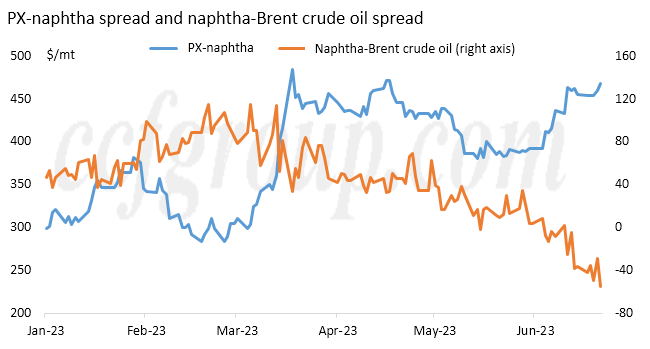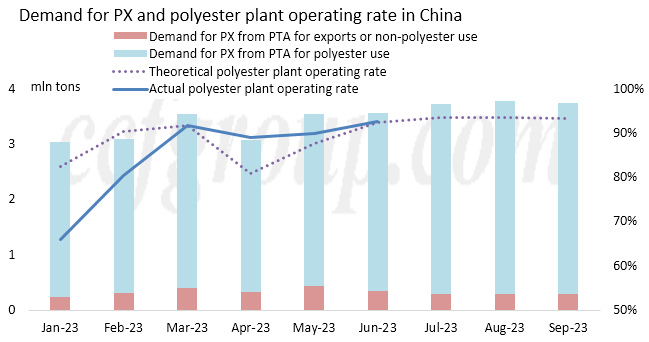PX supply and demand from polyester angle
Since Jun, PX-naphtha spread has been widening again, up from $380/mt in the beginning of the month to $450/mt after mid-Jun. Apart from the disruptions of production from large plants that drives up PX price, the sharp widening of PXN spread seems to be unexpected, as the turnaround season for PX plants in China is completing and plant operating rate is rising.
Firstly, feedstock naphtha is weak.

Since mid-Mar, naphtha to Brent crude oil futures spread has been fluctuating down for much of the time. In Jun, the downward move accelerated, with the spread squeezing from $22/mt in end-May straightly to -$56/mt as of Jun 23, down a whopping 257% and hitting new low since Sep 2022.
Naphtha weakened, dragged down by sluggish demand coupled with bounteous supply in Asia. It is one of the advancing momentum for PX-naphtha spread in terms of cost.
Secondly, PX gains profound support from demand.
China polyester market has been strong since Mar. Despite operating rate cuts in Apr, polyester plant operating rate has climbed up again since May, to above 90% in late May. According to the data compiled by CCFGroup, China domestic polyester production increased by 5.7% on year during Jan-Jun 2023. At the same time, newly-started polyester capacity reached more than 5.2 million mt/yr. From the perspective of polyester growth, it is a profound support to PX demand.

During Jan-Jun, based on China domestic PX production plus imports, excluding PX demand from PTA for exports or non-polyester use, the rest of PX supply goes to polyester application which can theoretically meet the requirements when polyester plant operating rate stands at around 88%. In fact, China polyester plant operating rate has been hovering around 89~93% since Mar, higher than what the PX supply can theoretically reach. Therefore, it testifies to why the profits in the industry chain center on PX.
In the future, on supply front, with fewer plants under maintenance, CNOOC Huizhou's new 1.5 mln mt/yr PX plant having started production and Sinopec HRCC's 1 mln mt/yr PX plant restarted, domestic PX production is expected to increase obviously, despite the maintenance of Sinopec HRCC's 660kt/yr plant and Fuhaichuang's PX lines as well as ZPC's maintenance plan. The production is expected to reach about 3 million tons a month, and PX imports are expected to stay at regular level.
In terms of demand, PTA exports are expected to decrease to 200-250kt a month, impacted by India's BIS certification policy. Based on that China polyester capacity is expected to expand by nearly 3.5 million mt/yr in the next three months, PX supply could meet the requirements when polyester plant operating rate keeps at 93~94% in the third quarter. However, with polyester plant operating rate at around 93%, further upward space would be limited, and the operating rate may move lower.
Therefore, from the perspective of polyester, tight PX supply could get alleviated, and PX inventory would increase in the third quarter.
The estimation above is based on high polyester plant operating rate, yet between PX and polyester, there's PTA. If PTA margin is poor and several plants undergoes maintenance, PTA inventory would reduce while PX inventory rise would accelerate. However, if PTA plant operating rate hovers high and PTA is supplied more than what can be consumed, PTA inventory would pile up while the pressure on PX would get relieved and PX processing spread would maintain high.
In a conclusion, either based on polyester or PTA, PX inventory is expected to increase gradually, bringing about pressure on the economics. Any squeeze of PX-naphtha spread would be slow, considering weak naphtha, low inventory and stocking requirements, while economics of PTA are likely to keep consolidation. If demand for PX unexpectedly reduce sharply due to intensive PTA plant turnarounds, the profit in the industry would shift from PX to PTA.
The prices of PX and PTA, in the lack of strong driving force, are expected to track crude oil as well as commodity market.
- Top keywords
- Cotton Price
- Cotton Futures Price
- Cotton Futures
- CZCE
- PTA Futures Price
- Chemical Fiber
- Polyester Prices
- Wool price
- PTA Futures
- Shengze Silk
- China
- Yarn Price
- price
- China Textile City
- Fibre Price
- Benzene Price
- Cotton
- Index
- Cotton Index
- PTA
- fabric price
- NYMEX
- Top 10
- textile industry
- Spot Cotton
- Cotton Yarn
- Polyester Price
- Futures
- PTA Price
- cotton yarn price

